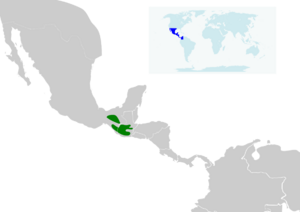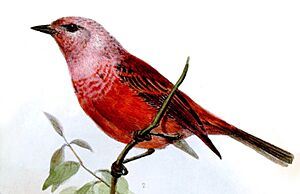Pink-headed warbler facts for kids
Quick facts for kids Pink-headed warbler |
|
|---|---|
 |
|
| Conservation status | |
| Scientific classification | |
| Genus: |
Cardellina
|
| Species: |
versicolor
|
 |
|
| Range of pink-headed warbler | |
| Synonyms | |
|
Ergaticus versicolor |
|
The pink-headed warbler (Cardellina versicolor) is a small passerine bird. It lives in the mountains of southwestern Guatemala. You can also find it in the central and southeastern mountains of Mexican Chiapas. This bird is mostly red. It has a shiny, silvery-pink head and chest.
It is a common bird in humid forests. These forests often have pine and oak trees. It lives at high places, from about 1,800 to 3,500 meters (5,900–11,500 ft) above sea level.
Contents
About Its Name and Family
When Osbert Salvin first described the pink-headed warbler in 1864, he put it in the Cardellina group. It was also briefly put with the American redstart birds. Later, in 1881, it moved to the Ergaticus group.
This bird is the only type in its small area. But it is very closely related to the red warbler. The red warbler lives in the mountains of Mexico, north of the Isthmus of Tehuantepec. Even though they live in different places and look quite different, some people thought they were the same species.
In 2010, scientists studied the DNA of wood-warblers. They found that the red and pink-headed warblers are closest relatives. Their shared ancestor came from a group that also led to the red-faced warbler. Because of this, scientists suggested moving both the red and pink-headed warblers back to the Cardellina group. The International Ornithologists' Union (IOC) now uses this new grouping.
The IOC officially calls it the "Pink-headed warbler." This name points to its most special feature. The group name Cardellina is Italian for a small European goldfinch. Its species name, versicolor, is Latin for 'of changeable colors'. This is because its head color can look different. Depending on how you see it, the head can look frosty pink or a deeper red. In Spanish, people call it cabeza plateada, which means 'silvery head'.
What Does It Look Like?

The pink-headed warbler is about 12.5 to 13.5 centimeters (4.9–5.3 in) long. It weighs about 10 grams (0.35 oz). Both male and female birds look similar. However, females are usually a bit duller in color.
Adult birds have dark red feathers on their upper body. Their chest is silvery-pink, and their belly is pinkish-red. Their head is silvery-pink with a reddish forehead. They have dark areas around their eyes and dark brown eyes. Their beak is blackish, sometimes with a horn color on the lower part. Their legs are flesh-colored.
Young pink-headed warblers are a rich brown color. Their underparts are slightly lighter. But they quickly change these feathers. By late summer, young birds look almost exactly like adults. Only their bones can show they are still young.
What Does It Sound Like?
The pink-headed warbler's call is high, thin, and sounds a bit like metal. People write it as tsiu, ssing, or tseeip. It also makes a soft, weak chip sound. This sound helps it stay in touch with its mate.
Its song is a series of short trills and chips. People say it sounds "clear and cheery." It reminds some of the yellow warbler's song. It is also slower and less varied than the red warbler's song. Only male birds sing. You can hear its calls all year. But the pink-headed warbler sings mostly from February to May. It is quiet during the rainy month of June.
Where Does It Live?
The pink-headed warbler lives only in the mountains of central and eastern Chiapas in Mexico. It also lives in western Guatemala. It is a common bird in humid forests. These forests have pine and oak trees, or pine and evergreen trees. It lives at high places, from about 1,800 to 3,500 meters (5,900–11,500 ft) above sea level.
It likes forests with thick, untouched plants on the ground. But it can also be found in disturbed forests in Guatemala. These places are not as good for them. Even though it is expected to be in El Salvador, no one has seen it there yet.
How Does It Behave?
It is rare to see more than two pink-headed warblers together. This is true unless they are feeding their young. Mated pairs usually stay together all year long.
What Does It Eat?
Like other New World warblers, the pink-headed warbler eats insects. It picks insects and other small creatures from plants. It mostly finds food in the thick plants close to the ground. It also flies out to catch insects in the air.
It usually looks for food about 2 to 5 meters (6.6–16.4 ft) off the ground. It rarely goes above 7 meters (23 ft). But during the time they raise young, the male might hunt near the tops of trees. He sings from these trees, sometimes as high as 15 meters (49 ft) up. This bird often joins groups of different bird species. These groups pass through its area. Sometimes, volcanic eruptions can cover plants with ash. This can affect insect numbers and cause fewer pink-headed warblers.
Life Cycle
In the spring, the male starts singing on nice days in early February. He keeps singing for several months. His singing is most frequent between March and May.
The female builds a round nest from pine needles. She builds it on the ground where there are many fallen pine needles. Often, she chooses a steep bank. She gathers pine needles from far away, more than 15 meters (49 ft) from the nest. She checks carefully for animals that might harm her nest before returning. Once the outside is done, she fills the bottom with soft plant materials. She lines it with moss.
She lays 2 to 4 eggs. The eggs are white with a ring of light brown spots at the wide end. They have a few light brown spots elsewhere. The eggs are about 17.1 by 13.3 millimeters (0.67 by 0.52 in) in size. Only the female sits on the eggs to keep them warm. This takes 16 days. She sits inside the domed nest with her tail sticking out. Her head is turned so she can see outside. She moves a lot while sitting on the eggs. She changes her position often. She spends about 71 percent of her time on the nest. She sits for 13 to 35 minutes at a time, with breaks of 4 to 13 minutes. Unlike many birds that nest on the ground, the pink-headed warbler does not pretend to be hurt to distract predators.
Young pink-headed warblers have a red lining in their mouths. This feature has helped scientists study how warblers are related. Young birds stay in the nest for about 10 to 12 days before they can fly. They start to form pairs by their first autumn.
Protecting the Pink-headed Warbler
The number of pink-headed warblers is going down. This is mainly because the cloud forests where they live are breaking into smaller pieces. However, the International Union for Conservation of Nature says the species is of least concern. This is because it lives in a very large area. Also, its numbers are not going down very quickly.
Mexico's government lists it as endangered in that country. In 1898, people said it was "common" in the mountains of central Chiapas. But in recent years, it has become the least common warbler in the mountains of northern Chiapas. This is based on bird counts there.


